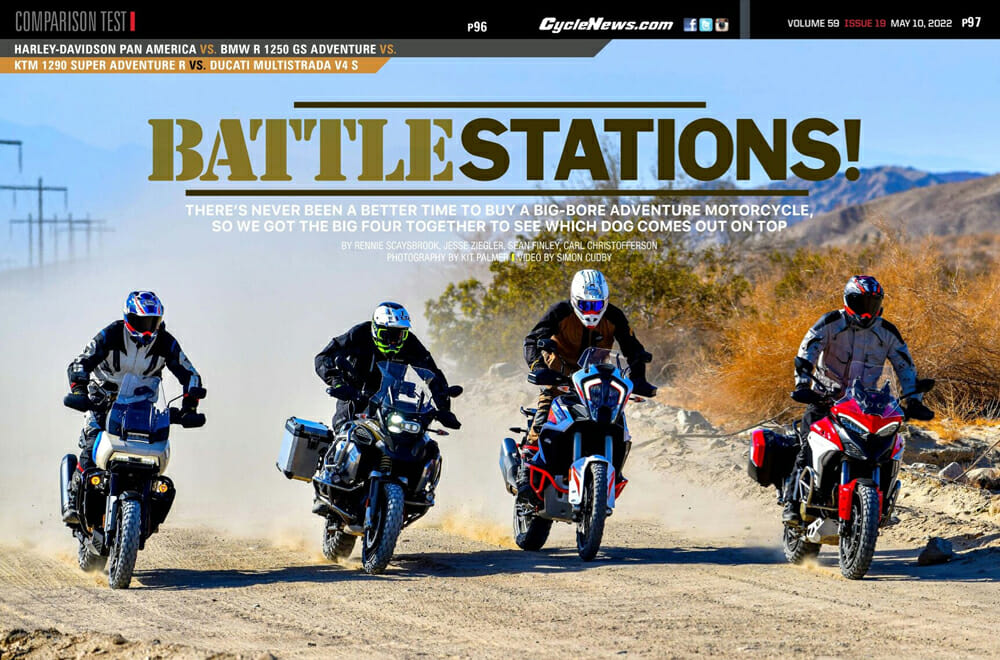Cycle News Staff | May 13, 2022
There’s never been a better time to buy a big-bore adventure motorcycle, so we got the big four together to see which dog comes out on top.
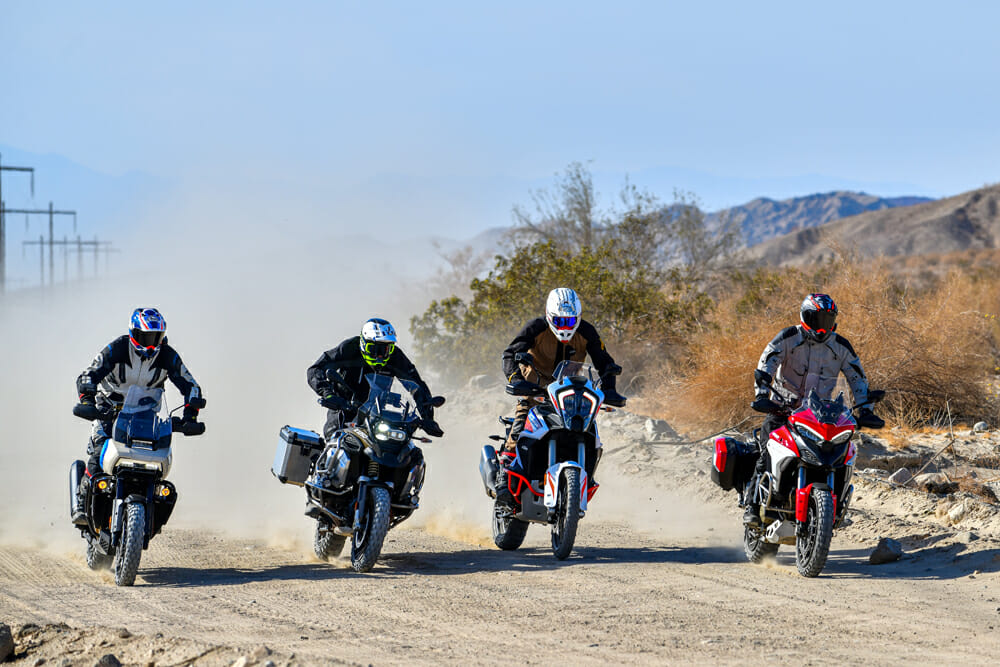
Harley-Davidson Pan America 1250 Special vs. BMW R 1250 GS Adventure vs. KTM 1290 Super Adventure R vs. Ducati Multistrada V4 S
By Rennie Scaysbrook, Jesse Ziegler, Sean Finley and Carl Christofferson
Photography by Kit Palmer
We’ve come a long way, haven’t we? Adventure motorcycles, at least in the top-tier big-bore (1200cc-plus) category, can now lay legitimate claim to being the most technologically advanced motorcycles on the planet, capable of traversing any kind of terrain, anywhere in the world, in supreme comfort and certainly speed.
The biggest of the big, this category is not for beginner riders. Indeed, many riders who buy these bikes will take them on dirt roads and rocky terrain occasionally at best, with most of the riding done on paved backroads as they go in search of, well, whatever got them riding that day.
We’ve gathered the traditional three in BMW, KTM and Ducati and thrown in the homeboy, Harley-Davidson, just to give them a bit of a red, white and blue mix.
Each bike is as standard as we could get them from the manufacturers, and as close as possible to what you’ll get in the showroom. Some of the bikes in this test were already fitted with aftermarket/performance parts, like BMW with their Enduro Pro mode, but mostly, they are very close to what you’ll pick up.
To score these bikes as fairly as possible, we tried to compare engine, chassis, and electronics performance, as well as value for money and each rider’s overall ranking. We then averaged them together to give the final order.
Let’s meet the players, shall we?
The Testers

Rennie Scaysbrook, Age: 39
Riding experience: I’ve been riding motorcycles for 35 years, started on dirt at four years old and now I ride everything from street to track to off-road and a lot of ADV.

Carl Christofferson, Age: 40
Riding experience: I grew up racing motocross and riding a lot in the mountains around Montana. The last few years I’ve been riding more ADV.

Sean Finley, Age: 53
Riding experience: I got a Honda MR 50 at five years old and have been riding off-road, motocross, street and ADV my whole life. These days, I mostly ride off-road and ADV.
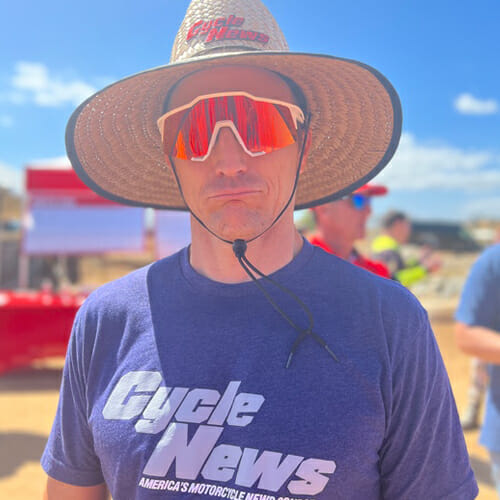
Jesse Ziegler, Age: 45
Riding experience: As a journalist, I’ve ridden almost every ADV, dual-sport and off-road bike since 2005. My background is dirt, but I enjoy street technology and performance more each year.
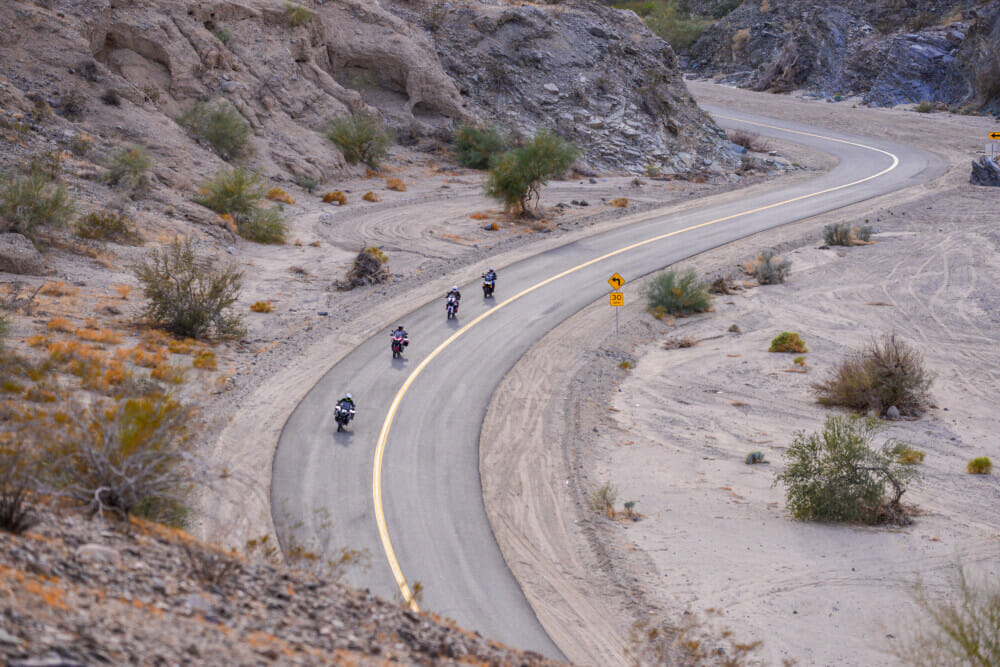
BMW R 1250 GS Adventure
Price as tested: $24,540
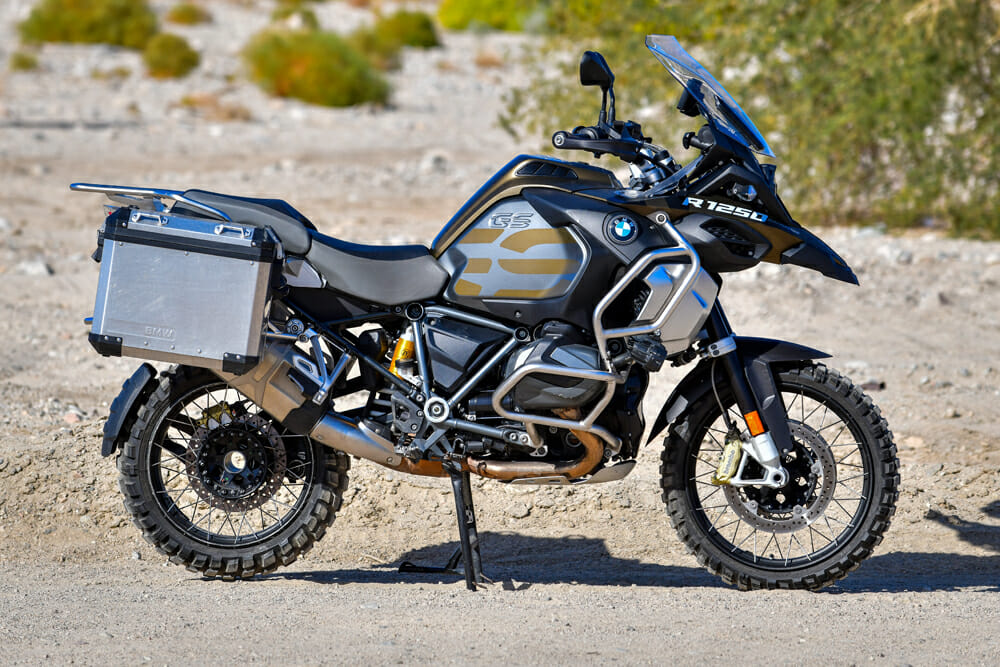 The grand old man of the big-bore ADV segment, the GS Adventure can still hang with the best of them in just about every area.
The grand old man of the big-bore ADV segment, the GS Adventure can still hang with the best of them in just about every area.
The grandfather of the adventure segment, the GSA is the bike everyone thinks of when talking big-capacity adventure riding. It’s the biggest of this four-bike gang, weighing at a measured 620 pounds with a topped 7.9 gallons of gas, which was boosted to 647 pounds when we put the alloy sidebags on.
It’s also the only bike that comes with a telelever front suspension setup, which helps the mammoth machine glide over silty dirt roads without letting the front-end get washed out.
The GSA comes with the trademark BMW flat-twin, measuring 1254cc with a claimed 134 hp and 105 lb-ft on tap. The seat height is a claimed 35 inches, with a tall-seat option available on 35.8 inches.
Our test bike was a 2020 model and thus had been fitted with a bunch of extras over the last two years. BMW is well known for rarely having a standard model on the showroom floor, as almost every GS that arrives has some form of aftermarket package fitted.
Our GSA came with the Premium and Touring Package which includes Dynamic ESA (Electronic Suspension Adjustment), a system that’s been around for ages that lets you choose between settings for rider, rider with luggage, two riders, two riders with luggage, etc.
On top of that, we had DTC (Dynamic Traction Control), heated grips, tire-pressure monitoring, and ABS Pro, which let us disengage the rear ABS for off-road riding.
The Touring Package included a proximity key, GPS, cruise control, LED auxiliary lights, and the mounts for the hard bags. We also had the Dynamic Package fitted, which gave us an up-and-down quickshifter and the Ride Modes Pro feature. Ride Modes Pro features Dynamic, Dynamic Pro, Enduro and Enduro Pro, which all have their own throttle, traction and suspension maps. Also included is Hill Start Control, dynamic brake assist, and engine-brake control.
Standard fitment for the GSA is a six-axis IMU that mitigates the ABS Pro system, three riding modes of Eco, Rain and Road, DTC, a USB charging socket, full LED lighting and a TFT color display.
All up, the extras thrown at our test bike amounted to a $4345 extra spent if you were picking this up at your dealer.
KTM 1290 Super Adventure R
Price as tested: $20,128.99
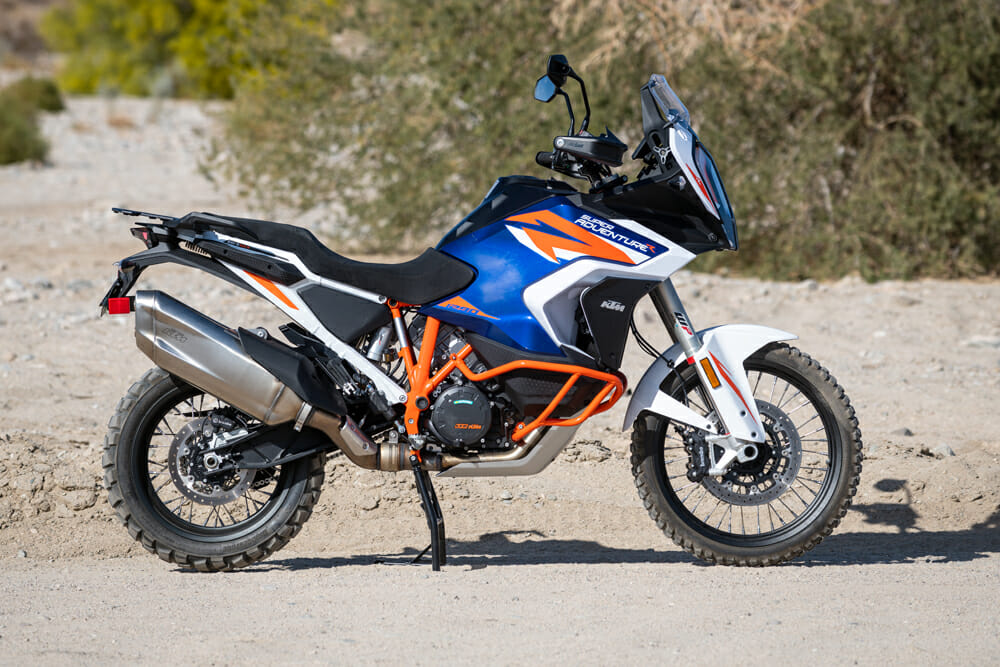 The KTM is the newest of the four bikes in the test and has gone through a complete redesign for 2022.
The KTM is the newest of the four bikes in the test and has gone through a complete redesign for 2022.
This is the only all-new machine in our four-bike test. The Super Adventure got a thorough make-over for this year (or rather, 2021, but we didn’t get it Stateside until this year), with a new, lighter chassis that’s got the steering head mounted 15mm closer to the rider and the swingarm now 15mm longer.
The suspension has been given a solid reworking, the motor’s also come in for a diet and the bodywork has been redesigned to work around the new split-style radiator. Said motor is a monster—160 hp from its 1301cc Super Duke-derived V-twin, it’s the kind of motor normally reserved for a racetrack rather than a dirt road. Those Austrian horses need to pull a measured 552 pounds with a topped 6.1 gallons of gas. The seat height is a claimed 34.6 inches.
Standard fitment includes traction control, cornering ABS, off-road ABS that lets you disengage the rear brake on the dirt, cruise control, those Rain, Street, Sport, Off-Road engine modes, keyless ignition, tire-pressure monitoring sensors and you can hook your phone up to the glorious seven-inch TFT dash and use the KTM My Ride system that allows Bluetooth for calls, music, and lets you use your maps. The dash lets you choose four “favorites” for the home screen, so you can see your presets at a glance.
KTM had already unlocked a few electronic gizmos on our test bike by the time we picked it up, so the bike wasn’t entirely stock. I say unlocked because that’s how KTM operates—everything has already been fitted at the factory, it’s just a matter of unlocking the various electronic guards to access the functions.
The Super Adventure gets two optional electronics upgrades, including the Rally Pack and the Tech Pack. Rally gets you the Rally riding mode to go with the four base modes, and you get nine-level adjustable traction control.
If you go for the Tech Pack, you get all the Rally Pack’s features plus Hill Hold Assist, Motor Slip Regulation, and the Quickshifter+ system for clutchless up-and-down gearshifts, which puts it on pretty much every level of the BMW.
All told, the extras on our bike made for a $629.99 upgrade to the $19,499 MSRP base price.
Harley-Davidson Pan America 1250 Special
Price as tested: $20,623
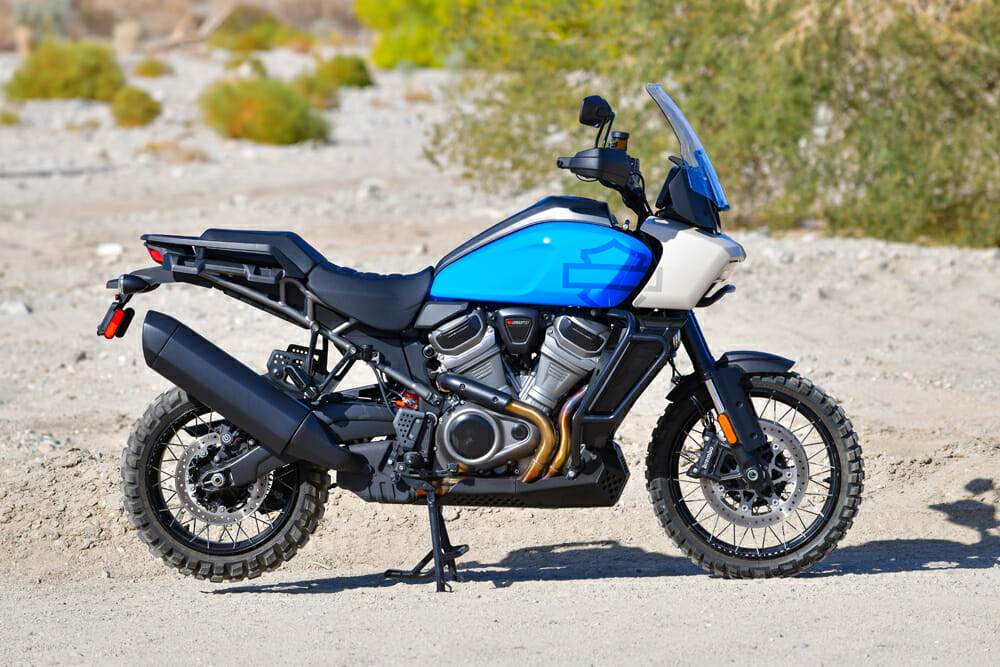 The Pan America 1250 Special is one of those happy surprises that rarely comes around in motorcycling.
The Pan America 1250 Special is one of those happy surprises that rarely comes around in motorcycling.
We love surprises here at Cycle News (pleasant ones, at least), and suffice to say the Harley-Davidson Pan America Special was right up there as far as 2021 was concerned.
The Bar & Shield really did its homework with the Pan America and the up-spec Pan America Special, creating a real alternative to the ADV steeds coming from Europe and Japan.
We tested the Special at the intro last year and it’s the same again for this test. Harley did give us a few options including the spoked wheels, blue paint, and adaptive ride height (of which they were the first to bring to market, even beating Ducati). Harley-Davidson claims the seat height is 31.1 inches, while we weighed the Pan America Special at 584 pounds with a topped 5.6 gallons of gas.
There’s actually not a massive difference between the base model and the Pan America Special. You get the same 150 hp Revolution Max V-twin motor and six-speed gearbox, the same chassis but the suspension is different—the Special gets 47mm semi-active electronic forks, and the wheels can come in spoked (pictured) as opposed to the cast-aluminum units.
The suspension has Comfort, Balanced, Sport, Off-Road Soft and Off-Road Firm damping profiles and works via the vehicle speed, suspension position, vertical acceleration, roll angle and rate, throttle and brake inputs and the selected Ride Mode.
Aside from that, you get traction control, cornering ABS, cruise control, hill-hold control, wheelie control, tire-pressuring monitoring, and there are five pre-programmed ride modes: Road, Sport, Rain, Off-Road and Off-Road Plus as well as two Custom Modes (A and B) and one Custom Off-Road Mode. There’s also the H-D Drag-Torque Slip Control (DTSC) system, which essentially adds torque to the rear wheel in heavy deceleration situations, such as aggressive downshifting. While the integrated slipper clutch will reduce wheel hop, DTSC takes it further, applying rotational torque to the rear wheel to maintain contact with the ground.
Our test bike was very close to stock. All Harley-Davidson did was fit their spoked wheels for an extra $624 and put some knobbies on, which we asked for. There were no extra tech packs or special electronics upgrades, although we should have asked for the optional quickshifter to be fitted. Our price came back at $20,623 MSRP.
Ducati Multistrada V4 S
Price as tested: $29,530.20
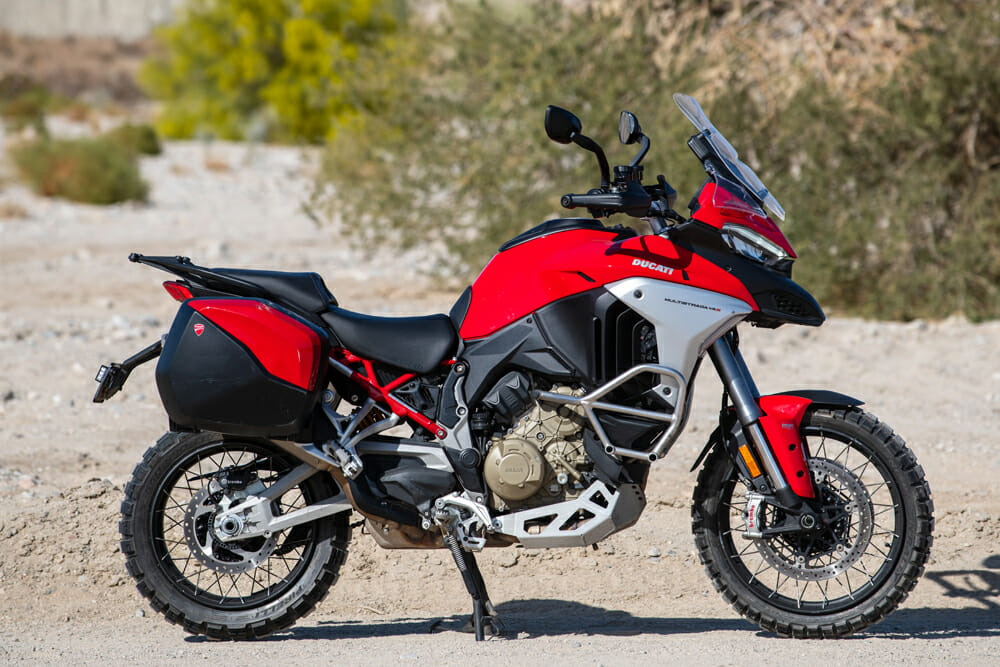 The Multistrada V4 S is as close to a superbike ADV that this segment will ever get. This thing is a beast.
The Multistrada V4 S is as close to a superbike ADV that this segment will ever get. This thing is a beast.
The Ducati Multistrada won Rennie’s Bike of The Year in 2021. It’s a truly excellent machine, and rated by Ducati themselves as the finest they have ever created.
Fitted with the raucous 1158cc Desmosedici Stradale V4 that first saw light in the Panigale a few years ago, you’ve got a whopping 170 claimed horsepower on tap and 92 lb-ft of torque, putting it straight to the top of the performance chart in a package that weighs a measured 577 pounds without the luggage that comes fitted as standard (the only one of the four to do so). With the luggage, you’re looking at 600 pounds on the dot with a topped 5.8 gallons of gas. Seat height is a claimed 33.1 inches, with a high-seat option of 33.9 inches.
The good thing with the Multi V4 S is you get pretty much all the bells and whistles as standard fitment. That means four Riding Modes, Power Modes, Cornering ABS, Ducati Traction Control, Ducati Wheelie Control, Daytime Running Light, Ducati Cornering Light, Ducati Quick Shift, Ducati Brake Light, Vehicle Hold Control, Cruise Control, Ducati Skyhook Suspension, and full LED lighting without the need to make aftermarket upgrades.
The Multistrada also lays claim to being the first production motorcycle to be fitted with Adaptive Cruise Control and Blind Spot Detection as standard, a feature that put it head and shoulders ahead of the rest in the tech game.
That doesn’t mean you don’t have any options to spend more cash on your Multi, no sir. Our test bike came with spoked wheels, and the optional Akrapovic titanium muffler, which added $1768. Then there were engine protection side guards at $624 and the bash plate at $343.20, which equals our list price of $29,530.20.
On the plus side, Ducati followed Harley-Davidson’s lead and fitted the minimum preload feature free-of-charge for 2022, something that can also be retro-fitted to a 2021 Multistrada V4 S. The system works by reducing the rear ride height as you come to a stop to make it easier to get both feet on the ground. It can be activated at speeds below 59 mph, and deactivated above 71 mph.
Fourth Place
Harley-Davidson Pan America Special
All four testers were genuinely surprised at how well the Harley performed. For a first-time ADV bike, the Harley is superbly executed, but it was always going to be an ask to topple bikes like the KTM and BMW.
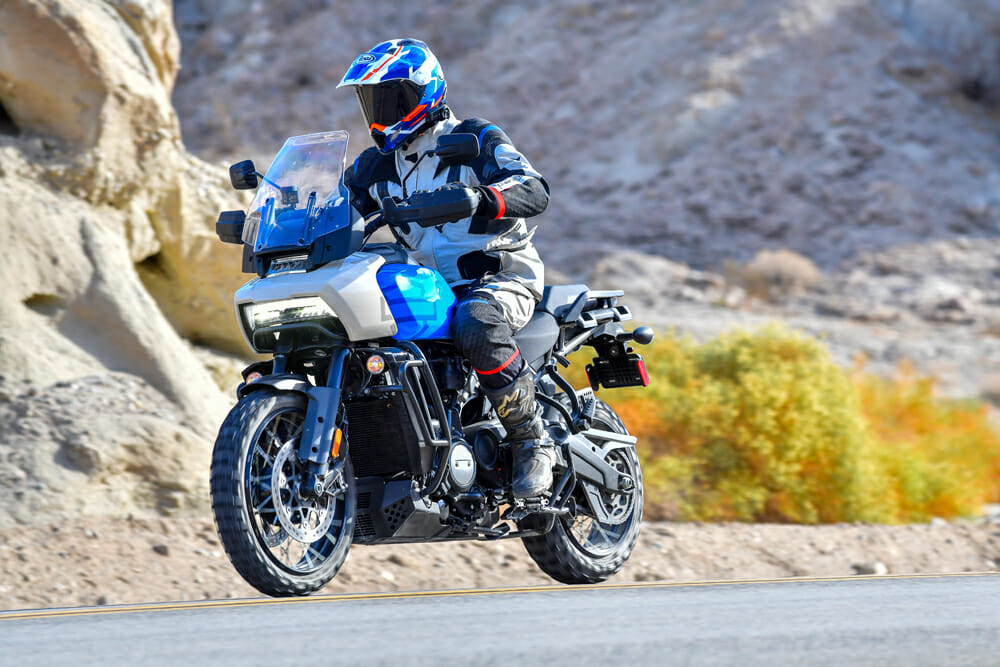
The Harley won points for its grunty engine performance at low rpm and ease of use when the dirt roads got silty and slippery but lost a few with each tester commenting on the excessive heat the Revolution Max V-twin let off, especially while touring around the street at low speed.
With the speeds up on the street, the heat issue goes away, but once you enter the next town and slow down, you’ll notice it straight away.
The Harley’s ergonomics were also a little strange, with a high-rise handlebar position perfect for when you stand up off-road but a touch too high for road touring. The Pan America’s weight is 552 pounds and its agility through the street twisties was evident. There’s a sporting edge to the Harley that shines through, but the road holding quality lacked a little when compared to the couch-like comfort of the BMW.
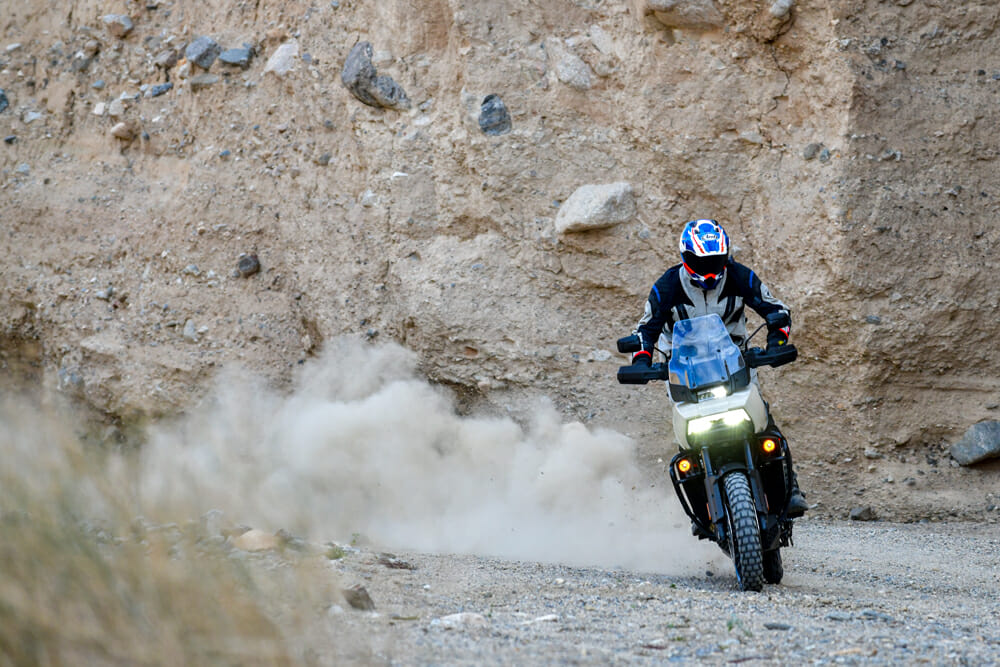
Given the base price is $17,319, you get exceptional value for money with the Harley. Another tick on the value side was the optional automatic ride-height adjuster, which is an excellent addition that should have been created by BMW years ago when they started developing the electronic suspension.
Speaking of the electronics, they were relatively easy to figure out and adjust, certainly way more than the Ducati’s which had all of us getting lost in the myriad of adjustments.
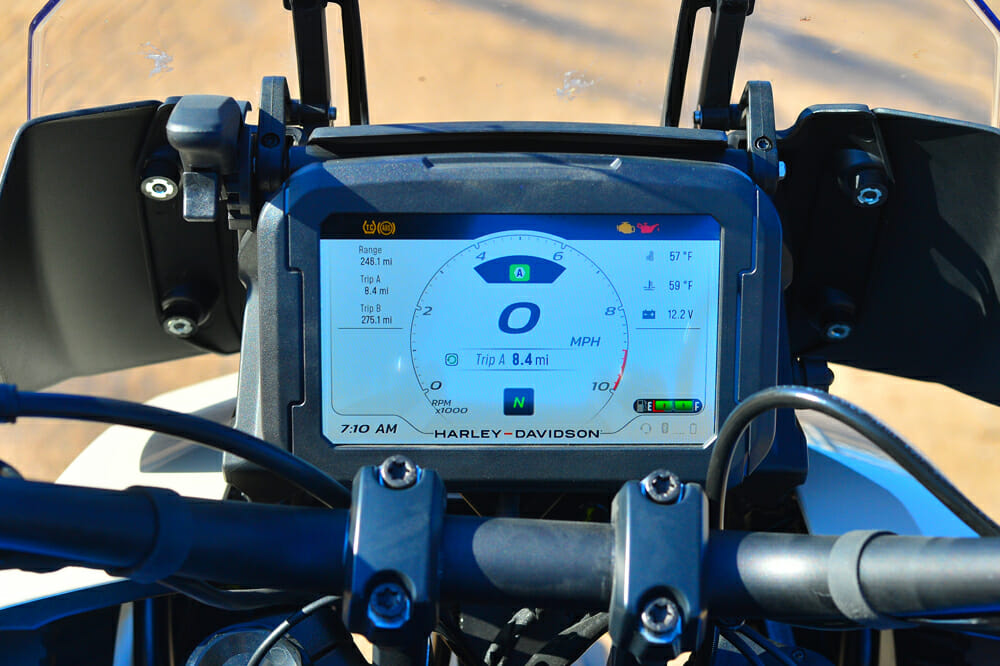
Although the Harley was ranked fourth in this test, that by no means indicates this is not a good bike. It is an excellent machine and when you consider this is Harley’s first go at the segment—and the fact it has the most famous name in motorcycling on the side of the tank—it is a real alternative to the status quo we’re so used to seeing.
“I think it’s the best bike for local riding, and it’s very user friendly with a cool style. I could ride it up to the lake and have fun but it’s not the most comfortable and it’s not the best off-road.” ~ Carl Christofferson
Third Place
BMW R 1250 GS Adventure
If this test were conducted 10 years ago, you’d almost guarantee the GSA would win. But times have changed, and the performance game has shifted substantially.
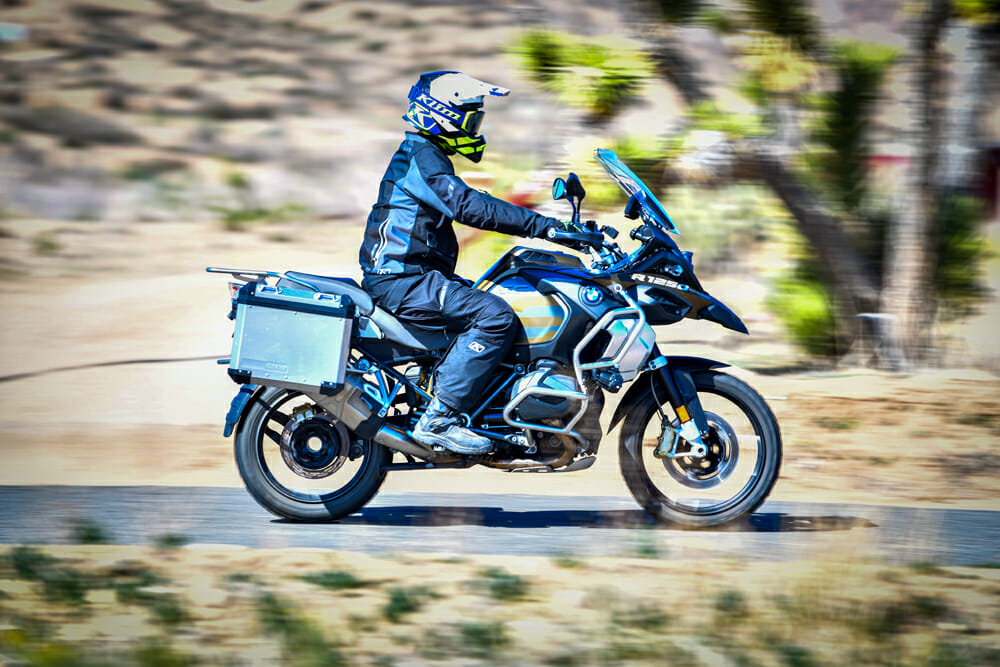
The GSA is by far the largest bike in the test, coming in at a measured 620 pounds, so it makes for a very intimidating motorcycle off road. That said, the telelever front end is almost built for mid-level off road riding and delivers a sure-footed feel to the rider that’s very difficult to match.
The enormity of the chassis, the suspension and the flat-twin motor translates into the best mile-munching street bike of the bunch here. Averaging 36.9 mpg across road and dirt riding, the ride on the road is velvety smooth, with every tester agreeing if this were plainly a touring test, the BMW would win, hands down.
Off-road, the BMW lost points for having some excessive driveshaft lash, which made small throttle applications on slippery surfaces a game of trial and error. This is offset somewhat by the stability of the chassis, but it’s still quite evident in practice.
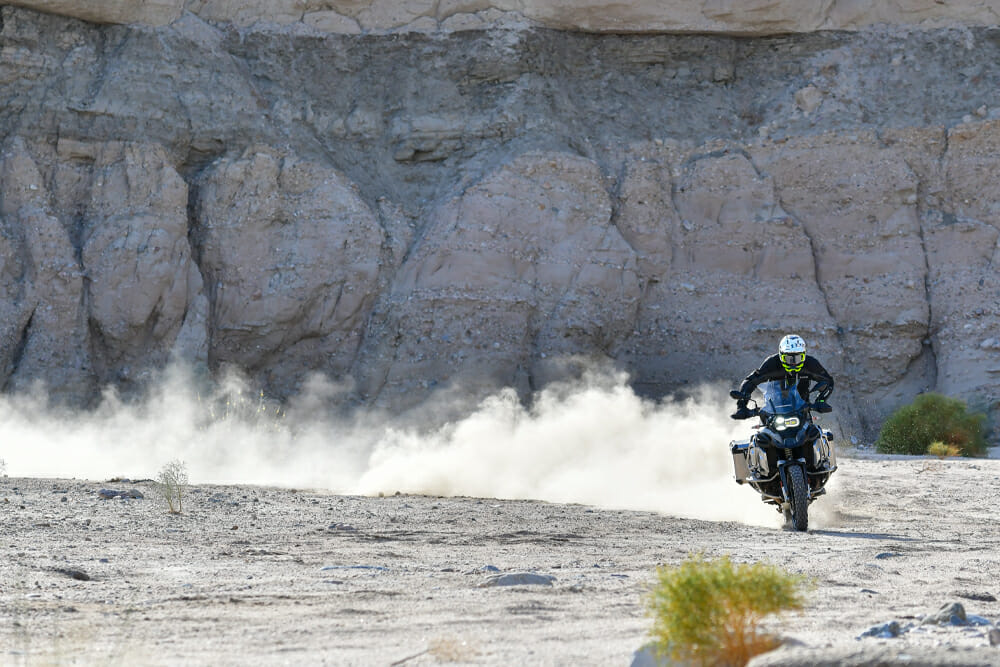
BMW can lay claim to being the initial proponents of electronic suspension, but the platform, indeed the whole electrical suite, feels a bit dated now compared to the KTM and Ducati. The Dynamic ESA (Electronic Suspension Adjustment) works well and has been around for some time, but the options available in terms of suspension performance from the Ducati especially saw it rank lower in the overall standings.
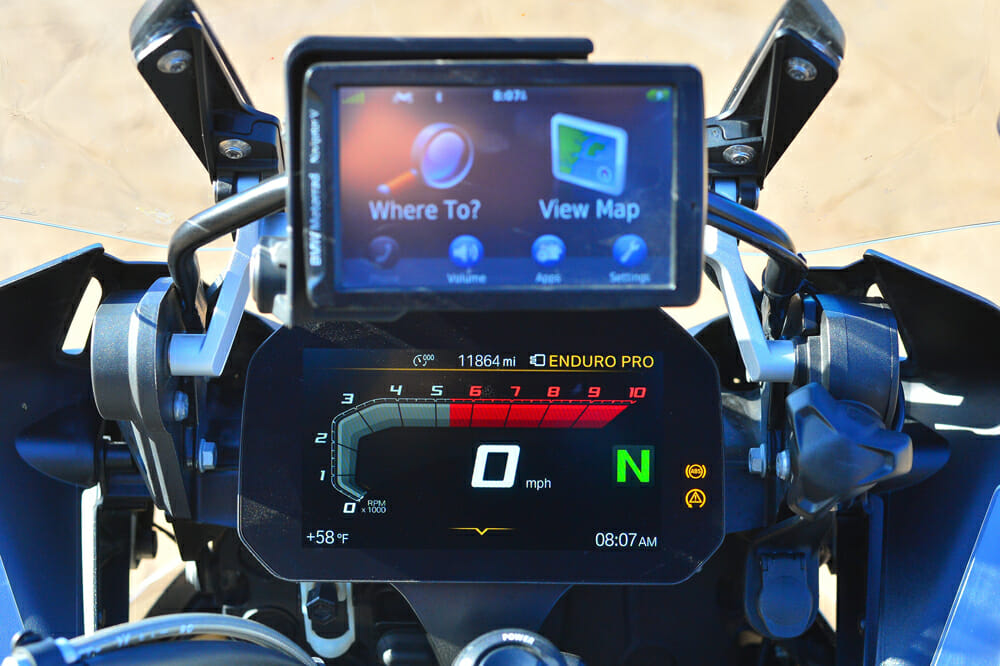
The BMW is the king of the freeway, but the KTM and Ducati have upped the game on dirt to a point that has seen the GSA drop to third overall. The overall platform hasn’t been comprehensively overhauled since 2013 when the water-cooled engine made its debut (save for the debut of the ShiftCam valvetrain in 2019), so it might be time for BMW to produce a new GSA. If that happens, BMW could well reclaim the title they held for so long.
“The GSA is biased towards big-mile touring across continents, and I prefer a bike that can behave a little more appropriately when the road gets rowdy. If it came down to long-distance comfort and that comfort alone, I’d pick this bike, hands down, without hesitation.” ~ Jesse Ziegler
Second Place
Ducati Multistrada V4 S
The Ducati is by far the best motorcycle here on the street. The V4 motor is an absolute ace, smooth as butter down low but with a superbike-style top-end that’s impossible to get the most out of at non-license shredding speeds.
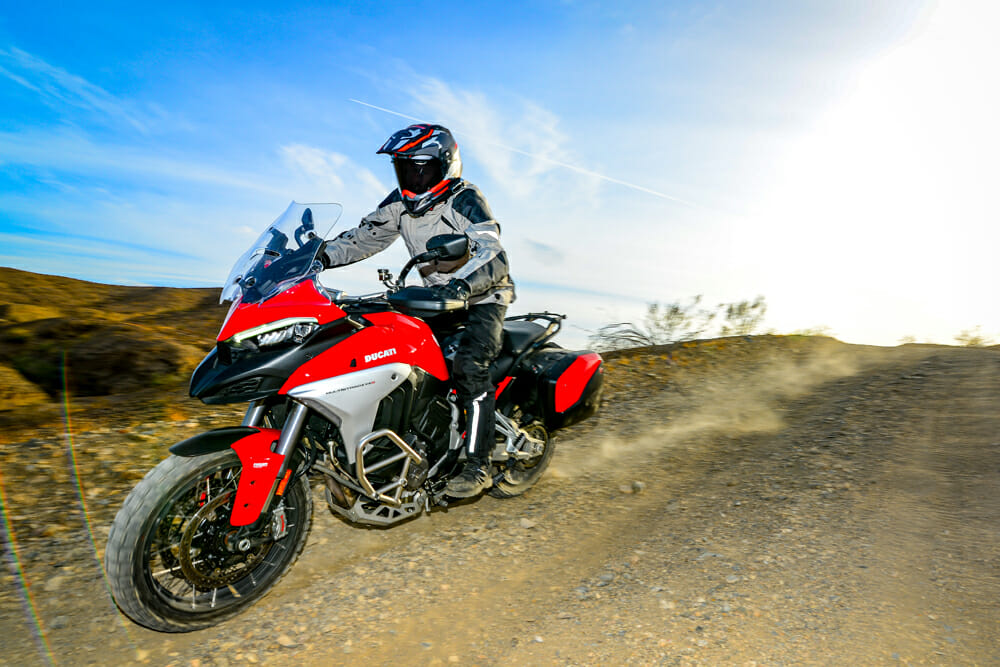
It’s also the most expensive bike here, again, by far. Ducati offsets the tested price of $29,530.20 by having pretty much every electronic bell and whistle fitted as standard (including the side cases, which can be swapped out for alloy ones), but you will have to pay extra if you want the spoked wheels.
We averaged 34.8 mpg on the Ducati, which made this bike the thirstiest of the test. The Ducati’s on-road performance, and we stress “performance,” is unmatched but it’s equally not in the same ballpark as the KTM off pavement. The V4 motor was noted a little peaky on dirt roads while the more on-road focused ergonomics hurt its performance on dirt.
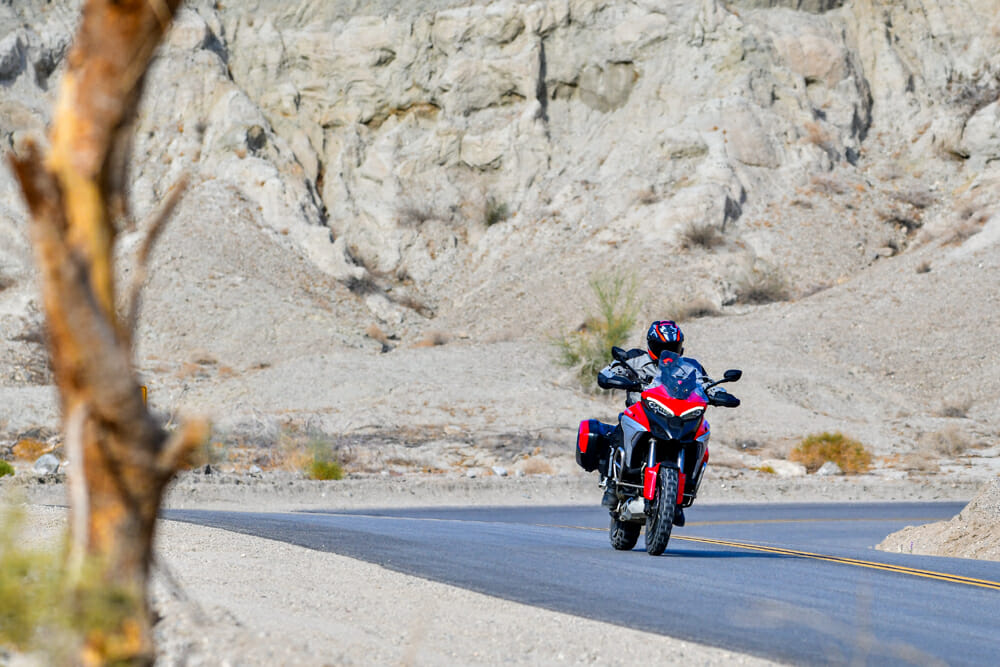
An area the Ducati got punched in the guts was in the electronics—not in the type of electronics it has (it’s got the most of any bike here)—but in adjusting and using them. Like the Honda Africa Twin DCT we tested last year, they’re not that easy to adjust and it’s simply a case of information overload.
Having said that, the Adaptive Cruise Control and Blind Spot Detection is a safety feature no bike this size should be without, and given the Ducati is the only one that has it, that’s a tick for the Italians.
The Ducati certainly feels the most “premium” of the bunch, which is both a good and bad thing. The good reason should be obvious enough—it’s a top-of-the-line Ducati, after all—but it’s also bad because it makes the rider petrified of scratching or, God forbid, dropping it. This is in contrast to the KTM, which doesn’t mind if it gets tipped over, thanks to the larger engine and crash bars.
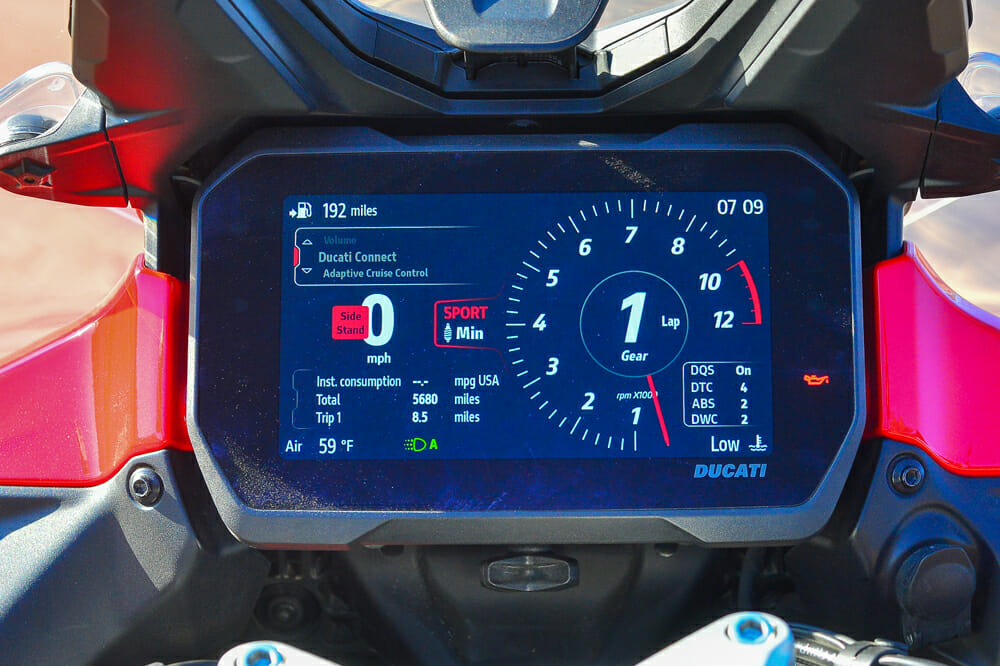
In the end, the killer for us was the price. Both Rennie and Sean picked it as their winner, but the difference between the KTM and Ducati is near $10k as tested and that fact was impossible to ignore. The Ducati obliterates the competition on the street and is also very good off-road, but not enough to topple the winner.
“The Ducati is the most fun and easy to ride on the street. The motor is powerful but smooth and controllable. The quickshift is the best of the three that had them fitted with barely any interruption in the acceleration and equally smooth while downshifting into turns.” ~ Sean Finley
First Place
KTM 1290 Super Adventure R
KTM really did their homework with the new Super Adventure. It has one of the finest V-twin motors ever created, the chassis performance is unparalleled off-road and the value for money is unquestionable.
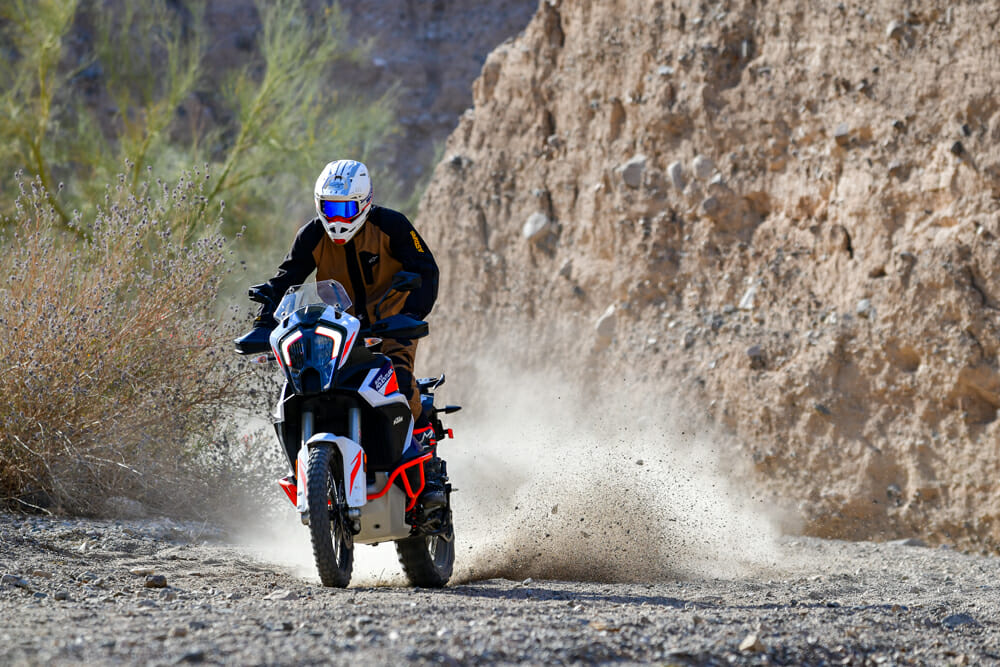
The 1301cc V-twin has way more performance than you’ll ever need for this category, and it’s a motor that can pull the double trick of being a doll at low speed and a beast when everything gets fast. The throttle response at low speed on dirt was exceptional, as it also was on moderate to fast road riding.
The engine was also the least thirsty, as we averaged 40 mpg after both road and dirt riding.
However, the KTM is not perfect. The 21-inch front wheel that makes the KTM such a winner off-road hurts it on the street, and when combining that with knobby tires on tarmac, the ride is a definite step down from the Ducati. The suspension, too, suffers on the street and doesn’t offer the same ride quality of the Ducati’s Skyhook setup. However, transfer the KTM to the dirt, and the ground lost to the Ducati on the street is more than made up.
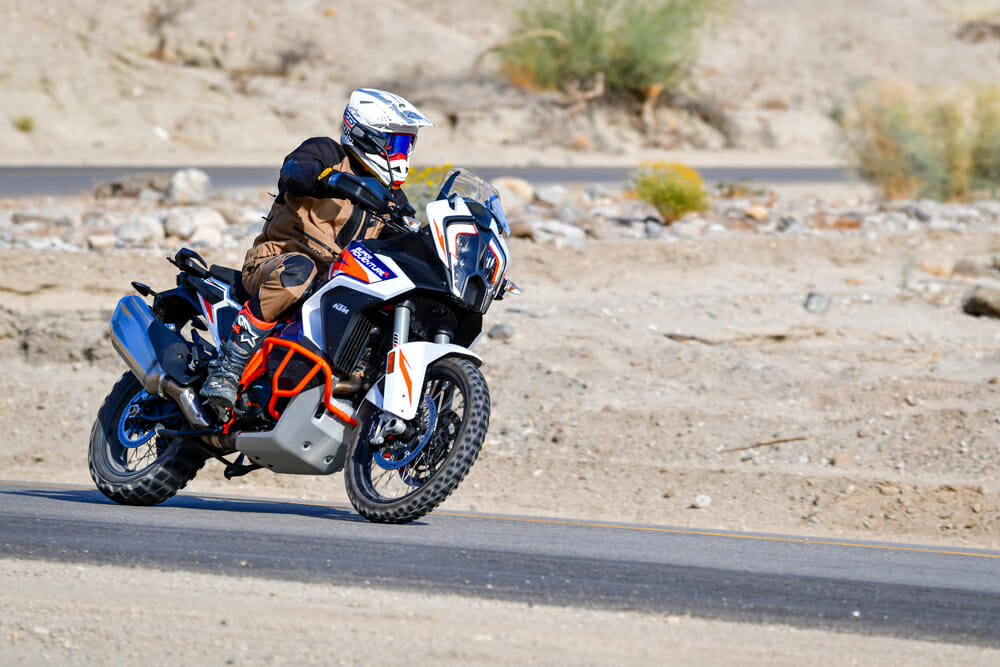
The KTM is a tall and relatively skinny machine despite having the highest capacity of any bike in the test. The ergonomics are definitely geared toward off-road performance, and when you stand up in the saddle you feel absolutely at home.
KTM’s spent a huge amount of resources in making the electronics as intuitive as possible. While there are almost as many parameters as the Ducati that can be changed, they are much easier to do so, and the massive seven-inch dash gives a classy feel to the electronic suite.
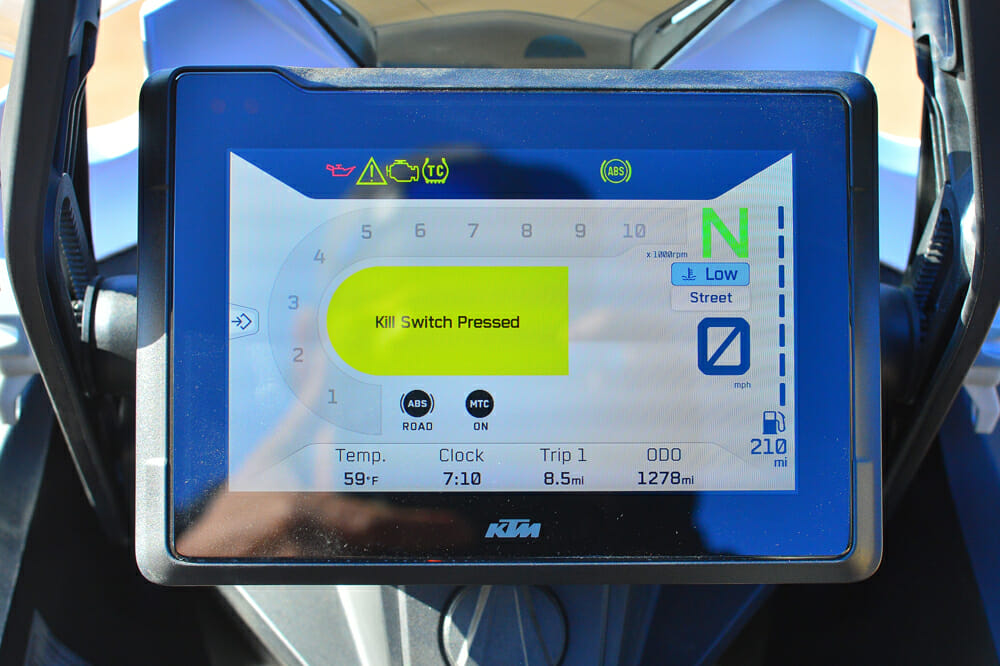
Another factor that helped the KTM was even if you bought the base Super Adventure R, unlocking all the really cool electronic features only added about $600 to the price.
The KTM is also the second-cheapest base price, and cheapest bike at $20,128.99 as tested, and given its performance advantage, especially off-road and given that it doesn’t lose that much on-road, that makes it difficult to deny as our winner.
“The KTM’s got such versatility built into it. It’s not as good as the Ducati when it comes to street performance, but the way it handles off-road riding, even at my average ability, made for what I would call the best compromise for a bike this size.” ~ Rennie Scaysbrook
VIDEO | 2022 Big-Bore Adventure Shootout
Video by Simon Cudby
You Get What You Want
Here’s the thing: each bike here would make a worthy addition to your garage. Unlike a 450cc dirt bike, there’s massive differences (but not disparities) in personality, performance and price with these four bikes. So, we’ll break it down into the following:
If you want street performance with good off-road manners and don’t mind spending a few bucks, go for the Ducati.
If you want the biggest, best mile-munching machine ever created, go for the BMW.
If you want stupendous dirt and near equal on-road performance, pick the KTM.
And if you want to be different (and don’t we all?), go for the surprise package of the test, the Harley-Davidson.CN
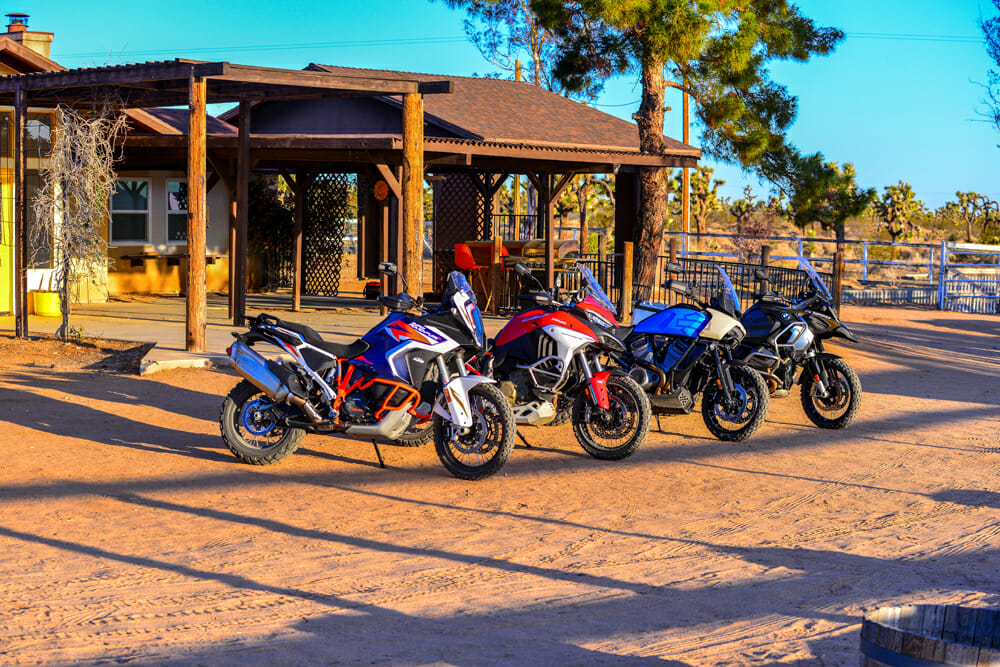
Where’s the Triumph Tiger 1200?
During our time spent testing the four ADV bikes in this comparison, Cycle News was invited to the international launch of the all-new 2023 Triumph Tiger 1200 lineup. While the latest Tiger hadn’t arrived stateside in time for our comparison, you can see our initial impression of the all-new Triumph (which has the BMW GS squarely in its crosshairs) in our first ride report.
KTM 1290 Super Adventure R Specifications
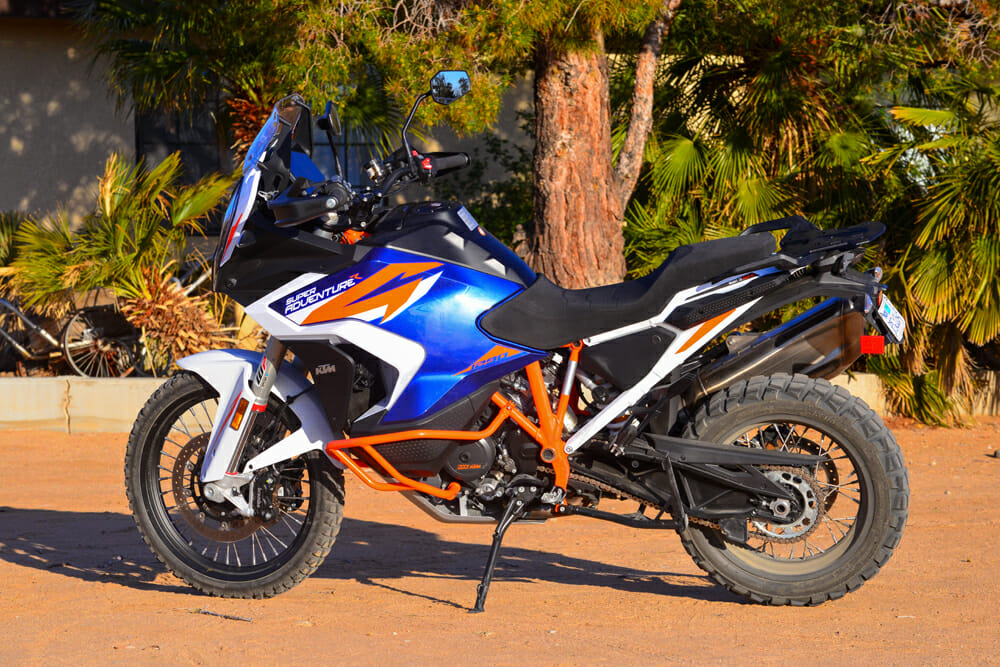
| MSRP: |
$20,128.99 (as tested) |
| Engine: |
4-stroke, V-twin |
| Valvetrain: |
4 valves per cylinder |
| Cooling System: |
Liquid |
| Displacement: |
1301cc |
| Bore x stroke: |
108 x 71mm |
| Compression ratio: |
N/A |
| Horsepower (claimed): |
N/A |
| Torque (claimed): |
N/A |
| Fuel system: |
Electronic, twin injectors per cylinder, full ride-by-wire 52mm elliptical throttle bodies, fixed-length intake system |
| Exhaust system: |
2-2-1 |
| Transmission: |
6-speed with optional Quickshifter+ |
| Clutch: |
PASC slipper clutch, hydraulically operated |
| Final drive: |
Chain |
| Electronics: |
Four Riding Modes, Power Modes, Cornering ABS, Traction Control, Quickshifter+, Vehicle Hold Control, Cruise Control, full LED lighting, Daytime Running Light, backlit handlebar switches, 7-in. TFT color display |
| Front suspension: |
48mm WP Xplor fork, fully adjustable |
| Rear suspension: |
WP Xplor PDS shock, fully adjustable |
| Front-wheel travel: |
8.6 in. |
| Rear-wheel travel: |
8.6 in. |
| Front tire: |
Bridgestone AX41 90/90 x 21 in. |
| Rear tire: |
Bridgestone AX41 150/70 x 18 in. |
| Front brake: |
Dual 320mm discs, radially mounted Brembo monobloc four-piston, 2-pad calipers, radial master cylinder, Cornering ABS |
| Rear brake: |
267mm disc, Brembo 2-piston caliper, Cornering ABS |
| Seat height: |
34.6 in. |
| Rake: |
25.3° |
| Trail: |
4.4 in. |
| Wheelbase: |
62 in. |
| Fuel economy (measured): |
40 mpg |
| Fuel capacity: |
6.1 gal. |
| Weight (measured): |
552 lbs. |
Ducati Multistrada V4 S Specifications
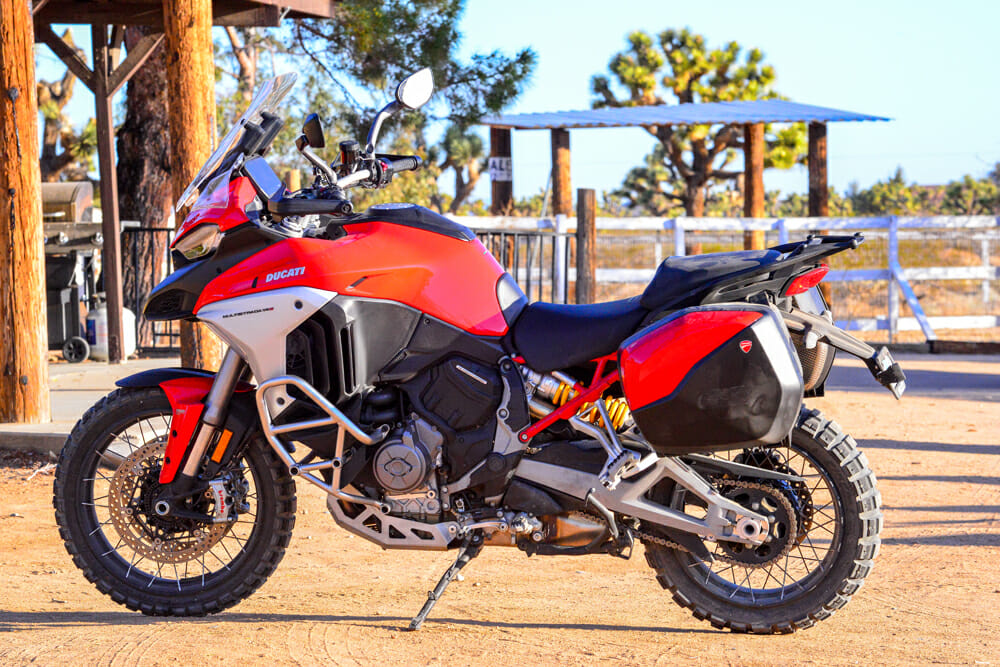
| MSRP: |
$29,530.20 (as tested) |
| Engine: |
Desmosedici Stradale 90° V4, rearward-rotating crankshaft |
| Valvetrain: |
4 Desmodromically actuated valves per cylinder |
| Cooling System: |
Liquid |
| Displacement: |
1158cc |
| Bore x stroke: |
83 x 53.5mm |
| Compression ratio: |
14.0:1 |
| Horsepower (claimed): |
170 hp at 10,500 rpm |
| Torque (claimed): |
92 lb-ft at 8750 rpm |
| Fuel system: |
Electronic fuel injection system, twin injectors per cylinder, full ride-by- wire 46mm elliptical throttle bodies, fixed length intake system |
| Exhaust system: |
4-2-1 |
| Transmission: |
6-speed with optional Quickshifter+ |
| Clutch: |
Hydraulically controlled slipper and self-servo wet multi-plate clutch |
| Final drive: |
Chain |
| Electronics: |
Four Riding Modes, Power Modes, Cornering ABS, Ducati Traction Control, Ducati Wheelie Control, Daytime Running Light, Ducati Cornering Light, Ducati Brake Light, Vehicle Hold Control, Cruise Control, Ducati Skyhook Suspension, full LED lighting |
| Front suspension: |
Marzocchi 50mm fork with TiN treatment, electronic compression and rebound damping adjustment with Ducati Skyhook Suspension, fully adjustable |
| Rear suspension: |
Marzocchi monoshock, electronic compression and rebound damping adjustment with Ducati Skyhook Suspension, aluminum double-sided swingarm, fully adjustable |
| Front-wheel travel: |
6.7 in. |
| Rear-wheel travel: |
7.1 in. |
| Front tire: |
Pirelli Scorpion Trail II 120/70 ZR19 in. |
| Rear tire: |
Pirelli Scorpion Trail II 170/60 ZR17 in. |
| Front brake: |
Dual 320mm semi-floating discs, radially mounted Brembo Monobloc Stylema 4-piston calipers, radial master-cylinder with Bosch Cornering ABS |
| Rear brake: |
265mm disc, 2-piston caliper with Bosch Cornering ABS |
| Seat height: |
Adjustable 33.1 in – 33.9 in. |
| Rake: |
24.5° |
| Trail: |
4.0 in. |
| Wheelbase: |
61.7 in. |
| Fuel economy (measured): |
34.8 mpg |
| Fuel capacity: |
5.8 gal. |
| Weight (wet, measured): |
577 lbs. / 600 lbs. w/ bags |
BMW R 1250 GS Adventure Specifications
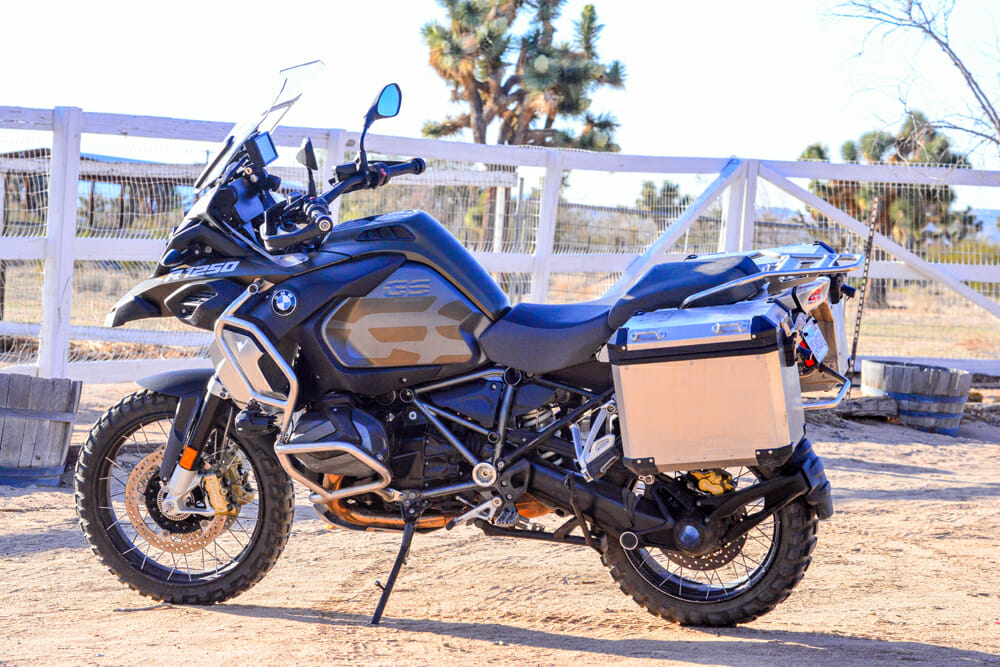
| MSRP: |
$24,540 (as tested) |
| Engine: |
4-stroke flat-twin, one balance shaft |
| Valvetrain: |
DOHC, 8-valve, variable engine timing system BMW ShiftCam |
| Cooling System: |
Air/liquid |
| Displacement: |
1254cc |
| Bore x stroke: |
102 x 76mm |
| Compression ratio: |
12.5:1 |
| Horsepower (claimed): |
136 hp at 7750 rpm |
| Torque (claimed): |
105 lb-ft at 6250 rpm |
| Fuel system: |
Electronic intake pipe injection |
| Exhaust system: |
2-2-1 |
| Transmission: |
6-speed |
| Clutch: |
Wet, assist & slip |
| Final drive: |
Shaft |
| Electronics (as tested): |
DTC Dynamic Traction Control, Heated Grips, TPM Tire Pressure Monitor, ABS Pro, Dynamic ESA, Keyless Ride, GPS Preparation, Cruise Control, LED Auxiliary Lights, Gear Shift Assist Pro, Ride Modes Pro |
| Frame: |
Two-section frame, front- and bolted on rear frame, load-bearing engine |
| Front suspension: |
BMW Motorrad Telelever; stanchion diameter 1.5-in. (37mm), central spring strut |
| Rear suspension: |
Cast aluminum single-sided swingarm with BMW Motorrad Paralever, spring pre-load, rebound damping adjustable |
| Front-wheel travel: |
8.3 in. |
| Rear-wheel travel: |
8.7 in. |
| Front tire: |
120/70 R 19 in. |
| Rear tire: |
170/60 R 17 in. |
| Front brake: |
Dual 305mm disc brake, floating brake discs, 4-piston radial calipers, ABS Pro |
| Rear brake: |
Single 276mm disc brake, 2-piston floating caliper, ABS Pro |
| Seat height: |
35.0 in. / 35.8 in. |
| Rake: |
26.3° |
| Trail: |
4.1 in. |
| Wheelbase: |
597 in. |
| Fuel economy (measured): |
36.9 mpg |
| Fuel capacity: |
7.9 gal. |
| Weight (measured with bags): |
620 lbs. |
Harley-Davidson Pan America 1250 Special Specifications
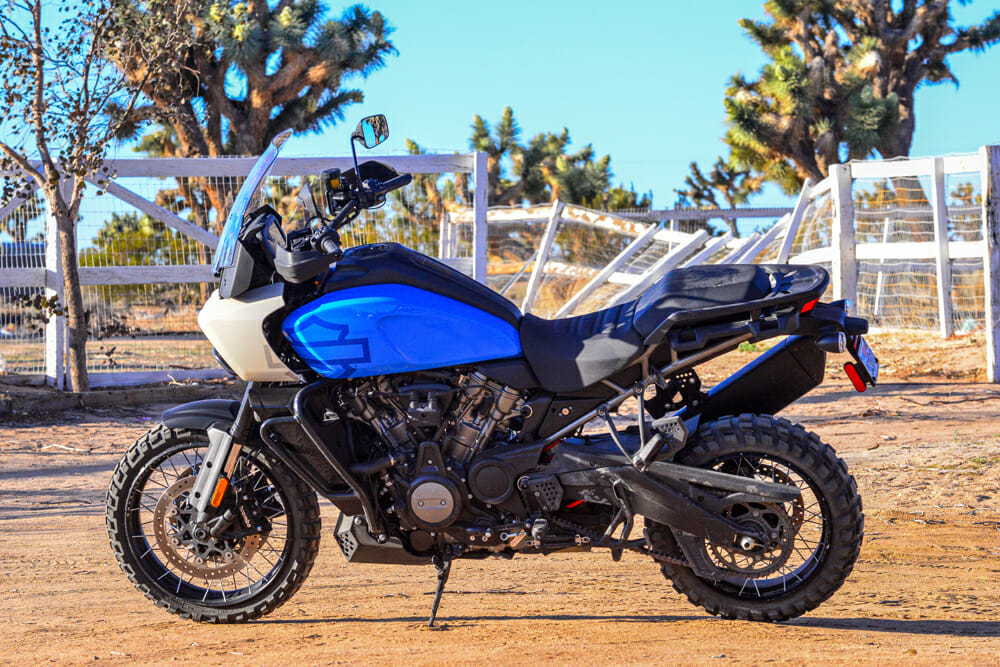
| MSRP: |
$20,623 (as tested) |
| Engine: |
Revolution Max 1250, 4-stroke |
| Cooling System: |
Liquid |
| Valvetrain: |
DOHC, 8-valve, chain-driven, VVT |
| Displacement: |
1252cc |
| Bore x stroke: |
105 x 72mm |
| Compression ratio: |
13.0:1 |
| Horsepower (claimed): |
150 hp at 9000 rpm |
| Torque (claimed): |
94 ft-lb at 6750 rpm |
| Fuel system: |
Electronic Sequential Port Fuel Injection (ESPFI) |
| Exhaust system: |
2-1-1, catalyst |
| Transmission: |
6-speed |
| Clutch: |
Wet, assist & slip |
| Final drive: |
Chain |
| Electronics: |
Showa semi-active suspension with adaptive ride height, Daymaker LED headlight, 6.8-in. TFT, Cornering ABS, traction control, TPMS, cruise control |
| Frame: |
Stressed member, alloy steel trellis frame |
| Front suspension: |
47mm inverted fork w/ electronically adjustable semi-active damping control |
| Rear suspension: |
Linkage-mounted monoshock w/ automatic electronic preload control and semi-active compression & rebound damping,
1-piece cast aluminum swingarm |
| Front-wheel travel: |
7.5 in. |
| Rear-wheel travel: |
7.5 in. |
| Front tire: |
Michelin Scorcher Adventure, 120/70R19 in. |
| Rear tire: |
Michelin Scorcher Adventure, 170/60R 17 in. |
| Front brake: |
Dual 320mm discs w/ 4-piston caliper, ABS |
| Rear brake: |
Single 280mm disc w/ 1-piston caliper, ABS |
| Seat height: |
31.1 in. |
| Rake: |
25° |
| Trail: |
6.2 in. |
| Wheelbase: |
62.2 in. |
| Fuel economy (measured): |
35 mpg |
| Fuel capacity: |
5.6 gal. w/ 1 gal. reserve |
| Weight (measured): |
552 lbs. |
